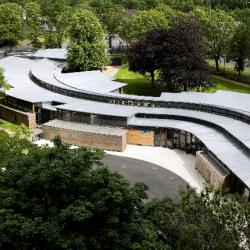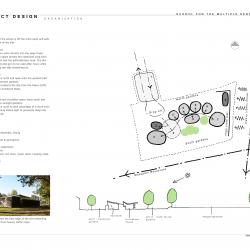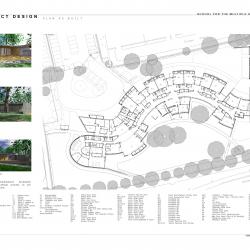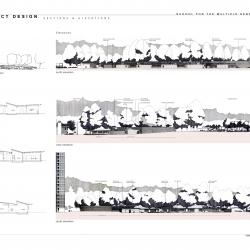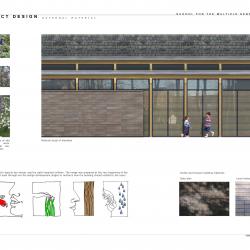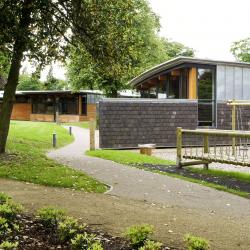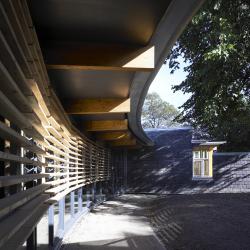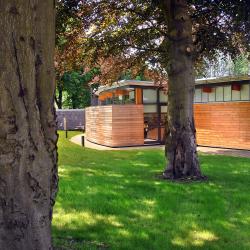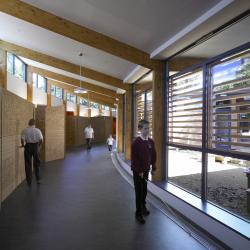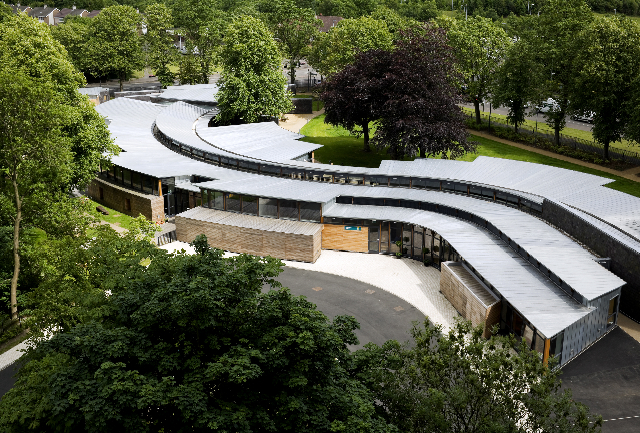
Introduction
Gordon Murray + Alan Dunlop Architects designed an extraordinary, internationally award-winning school that started with a most challenging set of constraints. Completed in July 2007, the designers took on the project with a ‘research and development’ perspective that set a high bar for innovative solutions to a complex brief and designed a space that was described by Hazelwood Head Teacher Monica McGeever: “Hazelwood is a beautiful building in which to work and learn. As soon as you enter you feel the vibrancy and sense of warmth that the building exudes.” The new school plus a small Life Skills House (150 square meters) is 28,632 square feet [2660 square meters]. Intended to be usable and easily navigated by anyone, Hazelwood provides accommodation for a maximum of 60 pupils, aged 3-18 years. The school snakes through the parkland site, forming gentle curves around the existing mature trees. The single story, built in natural materials, creates a series of small garden spaces ideal for small class sizes and maximizes the potential for more intimate outdoor teaching and learning opportunities. The distinctive curving interior spine meets the complex demands for an intuitive wayfinding system as well as the substantial storage needs for a wide range of equipment used by children with a variety of disabilities.
Description
Hazelwood sits on land owned by Glasgow City Council at the edge of Bellahouston Park. Major roads closely border the site. The site is shared with the Dumbreck conservation area as well as residential villas and a residential tower and was required to reflect neighbouring buildings in scale and height. The client also required that existing trees on the site be retained and that the building’s roofline remain below the first floor level of nearby homes that looked onto the site. The new school was to replace two existing schools serving children with disabilities, one with children who were had primarily vision impairments, some with co-occurring hearing limitations, and the other with a wide range of functional limitations, many children with multiple disabilities including learning disabilities and some with autism. Hazelwood had to merge schools that started with quite different student populations, very different teaching methodologies and both of which had previously been residential schools. In order to meet this unusual set of needs as well as the constraints of the site, Hazelwood’s designers needed to go far beyond the requirements of accessible school design and invent innovative solutions in partnership with the teachers, students and parents. The school snakes through the site, curving around existing trees. Its form creates a series of small garden spaces suitable to small class sizes and maximizes the opportunity for more intimate outdoor teaching and learning experiences. Internally, the curved form of the building reduces the visual scale of the main circulation spaces (the ‘street’) and helps remove the institutional feel that a single long corridor might create. Installation of tactile aids, contrasting colour and materials, and creation of uncluttered, readable interior and exterior spaces factored significantly in the design. Specific devices, such as the “Trail Rail” were designed to enable children to safely and independently navigate everywhere in the building.
Photos
Aerial View
Photo Credit:
Organizational Drawing
Photo Credit:
Plan
Photo Credit:
Sections and Elevations
Photo Credit:
Building Materials
Photo Credit:
School Grounds 1
Photo Credit:
Exterior Walls
Photo Credit:
School Grounds 2
Photo Credit:
Design and the User Experience
GM + AD Architects pursued the Hazelwood project with a commitment to building knowledge and capacity on a building that would work with children with a very complex range of abilities. Most extant examples are schools serving the needs of children with visual limitations, or hearing limitations, or cognitive issues or physical limitations. In this case, the design would need to meet the needs and enhance the independence of children with a mix of all of these issues. The initial phase of data gathering by the architect was replaced by joint research when the new Head Teacher was hired. The firm committed to extensive and continuous user engagement as well as the participation of specialized experts. Hazelwood’s Head Teacher worked closely with the design team in all phases of the project. Parents, teachers, ophthalmology and mobility experts, a Disability Discrimination Act (DDA) advisor, and children were also involved and included in the design process. Royal National Institute of Blind People (RNIB) Scotland was also consulted during the design process and worked closely with the school’s new Head Teacher.
The school contains eleven (11) classrooms in a single story structure, providing nursery through secondary education. All children arrive to Hazelwood by taxi or mini bus. The school entrance area was designed as a loop system to allow vehicles to rack up in a dedicated drop off area. The main entrance area opens to a large dining room, which doubles as the main assembly space.
The main teaching spaces are located to the quiet northern edge of the site in order to escape direct sunlight. The central circulation space houses a large cork-clad storage wall to accommodate the children’s equipment. Integrated into this wall is a unique “trail rail,” which provides tactile cues for the children to clearly and safely navigate the building. Each bay of sensory trail wall is individually shaped. This helps children orient the length of the circulation space in the school. Coupled with the ‘street’ design of the corridors in the school, this layout has proven an effective device for independent navigation for all kinds of students.
Signage throughout the school is redundant: in Braille, in pictures and in Moon (a system made up of lines and curves including some ordinary letters in simplified form), and has proven effective for the communication needs of the children. The subtle colors, contrast, and adaptable lighting elements maximize use of children’s residual vision.
Large classrooms are equipped with ample built-in storage space at the back of the room, and adaptable areas between the classrooms. The lack of clutter in the classrooms and on the walls elicits a calming atmosphere where children can flourish while not being bombarded by extraneous visual information. Some rooms offer viewing for staff and visitors without disturbing the children. These areas fulfill a dual function of quiet space when needed.
Design of the games hall, trampoline area, and hydrotherapy pool created opportunities for children to explore, extend their skills, and gain confidence through engagement in relatively independent activity. The playground and playground equipment allow each child the freedom to play as much as possible at his or her own level.
The external environment is an extension to the learning environment and numerous external teaching spaces are provided within the school grounds. Exterior material choices also contribute to successful navigation. A separate residential unit, the three bedroom “Life Skills House,” is used to teach the children basic life skills but also provides respite accommodation.
Evaluation
The key priorities for the client were a building that did not have an institutional feel, that would facilitate learning, independence and experience by students with disabilities that that would be safe but also challenging and also work well for teachers.
Exemplars in the design of Hazelwood are numerous. All aids for navigation or mobility are bespoke and integral to the design of the school building. The defining component of the interior design is the cork-clad ‘trail wall’ that meets navigation needs on one side and the extensive needs for storage on the opposite side. It runs the length of the building and enables children to navigate independently. In Hazelwood’s two predecessor schools, ‘trailing’ was limited in success because the environments had been retrofit and the necessary predictability of the system was never reliable. Within two weeks of exposure to the trail wall system, they were successfully moving around the building independently. The playground and playground furnishings enable children the freedom to play and take risks at their own level. Design of the games hall, trampoline area, and hydrotherapy pool provide children opportunity to explore, extend their skills, and gain confidence by relatively independent activity.
While no formal post-occupancy evaluation was conducted, feedback from users has been extremely positive. The building met and exceeded their expectations and delivered a marked improvement in the children’s level of independence. The environment facilitates and significantly eases learning to the children and the teaching / working environment for the staff has been a huge success. Technical standards (building regulations for Scotland) and standards defined by the Disability Discrimination Act were fully met but provided only a very basic floor upon which to build.
John Legg, Executive Director of RNIB Scotland (Royal National Institute of Blind People) wrote of Hazelwood, “It is without doubt an exemplary building which goes well beyond its functional brief in providing a highly attractive, effective and stimulating environment for blind and partially sighted children.” Caroline Ednie, of scottisharchitecture.com said, “The building is very much a product of an extended and detailed briefing process…designed to deal with very specific issues whilst ensuring an architectural quality. It’s a building that is designed not only to assist in the stimulation of the senses, but as an environment that stimulates the imagination. The building responds to what is ultimately a very challenging brief and this has been achieved by a fully comprehensive and continued dialogue with the client and end users.” (Ednie, 2007, p. 2)
One missed opportunity is that despite creating gear stowage space behind the trail rail wall, some staff regret that there is not still more storage space.
Universal Design Features
- The unique sensory trail wall weaves throughout the school and enables children to practice mobility and orientation skills, which lead to increased confidence, sense of mastery, and self-esteem.
- The trail rail wall is clad in cork, which has a warm feel and provides signifiers or tactile cues to assist children with orientation and navigation through the school.
- Each bay of sensory trail wall is individually shaped. This helps children orient along the length of the circulation space in the school.
- Corridors are designed as streets, which also assist with orientation and mobility.
- Redundant signage throughout the school, in Braille and pictograph and Moon, caters for the diverse communication abilities of all of the children.
- Large classrooms with ample storage space and adaptable areas between the classrooms.
- The focus-learning rooms offer viewing for staff and visitors without disturbing the children. These areas also offer quiet time as needed.
- The lack of clutter in the classrooms and on the walls generates a calming atmosphere without unnecessary visual confusion.
- The subtle color, contrast, and adaptable lighting elements maximize use of children’s residual vision.
- Use of contrasting and neutral color as visual indicators of transitional and storage spaces.
- Classrooms are oriented north facing to take advantage of a more even level of light and open onto the quietist part of the grounds, the classroom garden spaces.
- Storage ‘boxes’ to the rear of each classroom were designed to provide a solid wall and eliminate visual distraction for the children from outside.
- To reduce the effects of traffic noises proximal to Hazelwood, a majority of classroom spaces are located along the northern, quiet edge of the site and more transient spaces to the south. The ‘street’ links these areas and guides the building around the existing adjacent trees.
- The curved form means that both internally and externally the building is broken down into manageable spaces. The scale of these is then more appropriate for navigating and also minimizes any visual confusion by reducing the extent of the spaces.
- The building was developed as a series of space groupings for simple orientation.
- As the site is adjacent to a major traffic junction and in order to achieve the acoustic requirements of the teaching spaces, there are no operable windows within the classrooms. The building design was based on natural ventilation throughout. The depth of the storage boxes accommodates an attenuated acoustic fresh air plenum in lieu of opening windows.
- Acoustic ceilings are detailed into all teaching spaces to reduce higher volume reverberation.
- The overall roof form results in quiet, sheltered external teaching spaces shared between radial classrooms to the north.
- Naturally weathering larch boarding is used externally for the trail wall and stimulates he sense of smell as well as providing and appealing tactile surface.
- The transition between the ‘street’ and classrooms areas was designed to inform children of their location as well as school events. For instance, the roof over the street pitches to the north and clerestory glazing is incorporated. This is mirrored with glazing to the south, which floods the area with natural light. Through GM + AD’s research it became apparent that a good proportion of children who are blind can identify between natural and artificially lit environments.
- The transoms and sills are used for trailing and the sill doubles as a kerb which children may use to guide canes or the side of their feet along the street.
- All navigational devices, be it trail rails, window transoms or signage on doors, are set at a consistent height throughout the building so that they can be quickly located by the children.
- Differing tactile floor finishes serve as an alternative or enhancement to the trail walls for navigation and cuing in some locations inside the school.
- The design of the playground and playground equipment allows each child the freedom to play as much as possible at his or her own level.
- Design of the games hall, trampoline area and hydrotherapy pool allow children the opportunity to explore, extend their skills, and gain confidence through engagement in relatively independent activity.
- A high slate exterior wall protects the site from the loud traffic noises.
- The external structure and the cladding were all considered in terms of sensory stimulation. The structural glulam* timber frame casts shadows within the building to establish a clear pattern along the internal street of the school. *[By combining engineered strength with the warmth and beauty of wood, structural glued laminated timber (glulam) offers designers a multitude of options for large, open spaces with a minimum number of columns.]
- Roofing slates define particular areas outside, form a good trailing surface, and the tactile contrast to the timber clearly orients children as to location when outside. The slate also has the advantage on the south elevations of being a heat source for children to use as a navigation device.
- A network of paths around the school and the gardens vary in finish from bound gravel which crunches under foot to recycled bound rubber and timber decking. Each area is defined by separate finishes, which feel and sound different under foot.
Environmentally Sustainable Features
- Designed to maximize the use of natural and durable materials, and when fiscally possible, locally sourced.
- Naturally ventilated and insulated beyond the specific requirements of the national technical standards.
- Fully glazed circulation space faces south and overlooks large sunlit gardens.
- Roofing slates on the south elevations are a strong heat source.
- North facing classrooms pitch up to provide large areas of clerestory glazing to allow maximum day lighting to penetrate deep into classroom spaces and ensure an even distribution of light, critically important for children with visual impairments.
- The outside environment is considered as an external classroom. Areas have been left unplanted to allow the school’s involvement in the design and development of future sensory gardens.
Project Details
Location: Glasgow, Scotland
Completed: 2007
Client: Glasgow City Council Education Services
Design Team: Gordan Murray and Alan Dunlop Architects
Project Team
Architects
Gordon Murray, Alan Dunlop, Stacy Philips, Fergal Feeny.
Universal/Inclusive Design Consultant
Margaret Hickish (Buro Happold).
Landscape Designer
Richard East (City Design Cooperative).
Contractor
Paul McCrorey (Sir Robert McAlpine).
Engineer
Graham Hayne (Buro Happold).
Acoustics Consultant
Chris Steele (RMP).
Lighting Consultant
Laura Jones (Buro Happold).
Additional information
Funding By


Propose a Case Study
Help us improve our Case Study library

